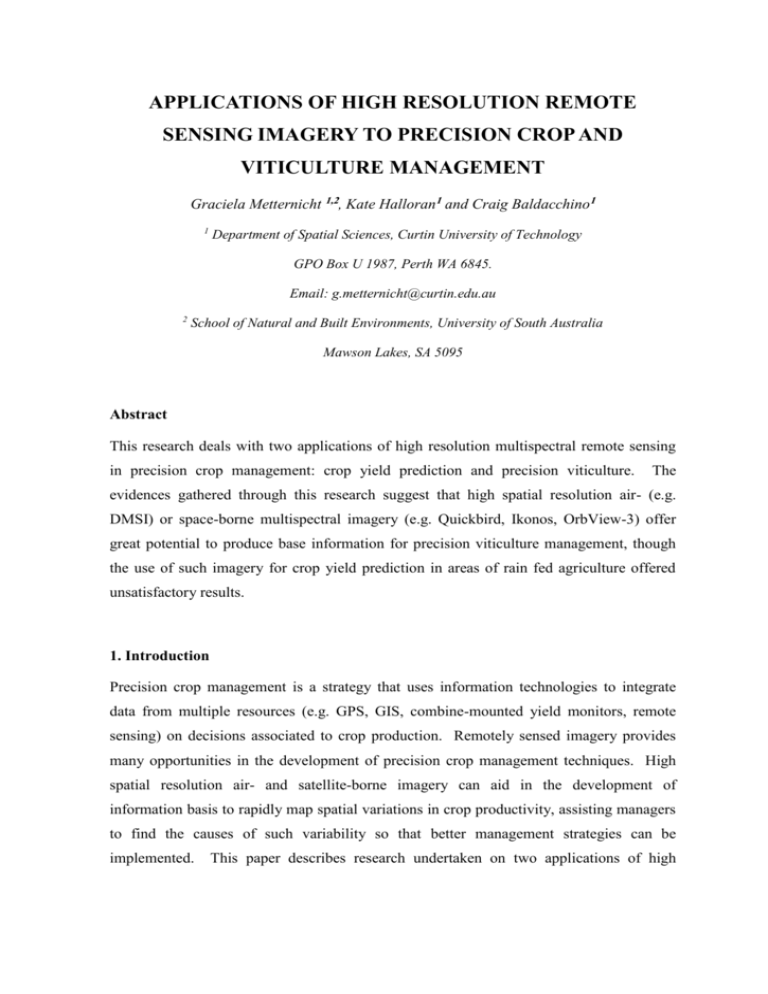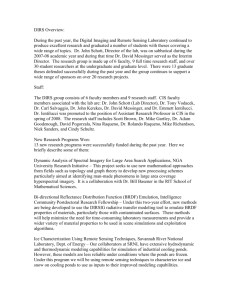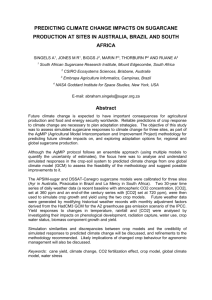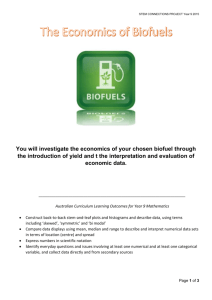Applications of high resolution remote sensing imagery to precision
advertisement

APPLICATIONS OF HIGH RESOLUTION REMOTE SENSING IMAGERY TO PRECISION CROP AND VITICULTURE MANAGEMENT Graciela Metternicht 1,2, Kate Halloran1 and Craig Baldacchino1 1 Department of Spatial Sciences, Curtin University of Technology GPO Box U 1987, Perth WA 6845. Email: g.metternicht@curtin.edu.au 2 School of Natural and Built Environments, University of South Australia Mawson Lakes, SA 5095 Abstract This research deals with two applications of high resolution multispectral remote sensing in precision crop management: crop yield prediction and precision viticulture. The evidences gathered through this research suggest that high spatial resolution air- (e.g. DMSI) or space-borne multispectral imagery (e.g. Quickbird, Ikonos, OrbView-3) offer great potential to produce base information for precision viticulture management, though the use of such imagery for crop yield prediction in areas of rain fed agriculture offered unsatisfactory results. 1. Introduction Precision crop management is a strategy that uses information technologies to integrate data from multiple resources (e.g. GPS, GIS, combine-mounted yield monitors, remote sensing) on decisions associated to crop production. Remotely sensed imagery provides many opportunities in the development of precision crop management techniques. High spatial resolution air- and satellite-borne imagery can aid in the development of information basis to rapidly map spatial variations in crop productivity, assisting managers to find the causes of such variability so that better management strategies can be implemented. This paper describes research undertaken on two applications of high resolution multispectral remote sensing in precision crop management: crop yield prediction and precision viticulture. The capability to predict crop yield before harvesting is an important factor, as it enables farm managers to change farming practices throughout the growing season in order to maximise profit and yield, while minimising costs. Halloran (2004) reviews several studies investigating the statistical relationships between remotely sensed data and yield data for inclusion in crop growth models, where yield predictions show strong results, providing evidence to hypothesise there would also be a relationship for the study area selected for this research using DMSI. On the other hand, grapevines are typical row crops where plant vigour is expressed not only as canopy density, but also in canopy dimensions. Information on the spatial extent of the canopy enables vineyard managers to determine where they should apply specific management techniques that maximise final production. In recent years yield maps produced by grape yield monitoring in Australia have shown that up to eight fold differences in yield can occur within a single vineyard block. Thus methodologies for accurately mapping the extent and variability of wine rows using non invasive remote sensing techniques are of paramount importance for better management strategies. Two aspects of remote sensing, namely spatial and spectral resolution greatly influence the accuracy of vine rows mapping. Previous researches suggest the use of imagery with a pixel resolution of up to 3 m. The sensor’s spectral resolution has important properties such as the position in the spectrum, the bandwith and the number of spectral bands, as these combined determine the extent to which individual targets (e.g. bare soil, vines, interrow vegetation) can be discriminated. In regards to precision viticulture, the main interest was on assessing the potential of DMSI imagery to accurately map individual wine rows using advanced object-oriented classification techniques. Specifically, this research wants to ascertain whether object oriented techniques of classification can produce results where inter row vegetative growth can be left out of the final classification. The process of classification using an object-oriented approach is generally broken down into two stages. The first stage is generating image objects of a suitable size and shape, and then secondly using certain criteria to aggregate the data into suitable classes. 2. Methodology 2.1 Remote sensing data The airborne camera system used for data collection is owned and operated by Perth Company Specterra Services, and was flown in a Cessna 303. DMSC is image data of the same scene recorded simultaneously through 4 narrow spectral bands. The DMSC system integrates 4 individual CCD’s capable of measuring ground reflectance at high resolution (0.5metre - 2metre) and high sensitivity within visible and near-infrared wavelengths. The 4 spectral bands were designed for vegetation mapping and monitoring, with 20 nanometres width and centred about the principal reflectance spectra features of vegetation (Figure 1). DMSI Spectral Band and Vegetation Reflectance feature Band1 Blue- 450nm (leaf pigment absorption) Band2 Green – 550nm (relatively higher reflectance and transmission) Band3 Red – 675nm (strong chlorophyll absorption) Band4 Near Infrared – 780nm (high infrared reflectance "plateau") Figure 1: Spectral configuration of the DMSI sensor. 2.3 Study areas Research on the relationship between crop yield and multi-season acquisition of high spatial resolution digital multispectral data (DMSI) was undertaken at the Muresk Agricultural Institute, a 2,000 ha farm located East of the Perth city, in the agricultural belt of Western Australia (Figure 2). Research into the classification of vines was completed at a property located close to the city of Adelaide, in South Australia (Figure 2). Figure 2: Study areas location in Western Australia and South Australia. Source: Google Earth 2.3 Remote sensing of vine rows: an object-oriented approach The use of an object oriented approach accounting for the targets’ structure, shape, size and spectral characteristics enabled accurate mapping of wine rows. Within eCognition (Defiens, 2003), raw DMSI bands and spectral indices, namely a simple ratio of NIR to red and the NDVI were segmented, and subsequently classified using a fuzzy classification technique. As mentioned previously the first stage in using eCognition’s classification procedure is to produce image sub-objects. This is the process of image segmentation where the image is divided into small objects based on the user’s criterion. Several options are available where the user can specify such things as scale, colour to shape ratio, compactness to smoothness ratio, and individual weightings of input layers (Figure 3). Figure 3 : Segmentation Interface (eCognition Professional) This step of segmentation is the starting point to determine how the rest of the classification will be built. The approach can be of two directions; either a bottom up or a top down approach will follow depending on the final result required and the size of the image objects. Generally, if small image objects are created initially then a merging of objects will be required. On the other hand, if large initial objects are created then a further subdivision of objects will be needed. The factor that has the greatest impact on object size is the scale parameter. Scale is an abstract term which determines the maximum change in heterogeneity that may occur when merging two image objects, and controls termination of the segmentation algorithm. Determining the scale parameter to use for the intended result is somewhat of a trial and error method as factors such as image resolution, image homogeneity, radiometric resolution and the final desired result all contribute to the value used. Although both bottom up and top down approaches were tested, best results were obtained from using smaller image objects that resulted from using a scale values of less than 10. The heterogeneity criterion is divided into two components: one criterion exists which is a measure of tone and the other criterion a measure for shape. Tone is a spectral criterion and is an evaluation of the change in heterogeneity when merging two image objects as described by the difference of the weighted standard deviation of the spectral values with regard to their weightings (Definiens, 2004). The shape criterion is a value that enables a user to improve the shape of the objects produced in regard to two different models. These models evaluate a shapes compactness or smoothness, which either makes an object either compact and rounded or elongated and smooth. As vine rows are elongated and smooth it made sense to use a high smoothness criterion to take advantage of this nature. After image segmentation the user has the choice to apply a nearest neighbour classification or use fuzzy classifiers. The choice was made to use fuzzy classifiers as shape was considered an important aspect in vine row separation. The basis of this classification was to use spectral combinations with differing fuzzy membership function to define two classes, vegetation and non-vegetation. After these classes were created, vines were separated from other vegetation types by use of the inherent spatial features of the objects. Once the vine was identified and classified into a separate class these image objects were merged to form long individual vine rows. The workflow of this process is shown in figure 4. Figure 4 : Workflow in eCognition Choice of fuzzy membership function was critical to class assignment, and as such the choice was based on the nature of the data. Two main types appeared most effective, linear and sinusoidal. The linear membership function best represented spectral features that changed gradually such as object means and some shape factors. The sinusoidal membership functions were used solely on the spectral feature of the ‘ratio’ value of band 3 (Red) as there appeared to be significant difference between vine and inter-row values. Examples of fuzzy membership functions are shown in figure 5. Figure 5 : Fuzzy Membership Function: Linear and Sinusoidal The choice of fuzzy rule base for the combination of the different fuzzy memberships made considerable differences to the outcome of the final classification. The use of fuzzy minimum, fuzzy algebraic product, and fuzzy algebraic sum were investigated and did cause radical differences in the results, but fuzzy minimum was used to simplify the classification procedure. Once the final classification is created, eCognition enables the user choosing which classes to extract as polygons. As only vine rows were of interest to this project, only vine row polygons were extracted (Figure 6). They were exported as ESRI (.shp) files. As the classification process is raster-based the polygons extracted are very detailed, as they follow the raster exactly, at a spatial resolution of 0.5m (e.g. the resolution of the DMSI imagery). Figure 6: Vine rows automatically extracted using the object oriented classification. Vine rows are shown in red colour, whereas the cyan-green colours correspond to inter-vine space. 2.4 Remote sensing based yield prediction Remote yield prediction in this research was undertaken using two sets of multispectral imagery (Figure 7a) collected during the growing season of year 2002, specifically in June 2002 (about 8 weeks after planting) and September 2002, when crop canopy was almost at full coverage. Image transformations (e.g NDVIgreen, NDVI, Plant Pigment Index, Photosynthetic Vigour Index) described in Metternicht (2003) and digital counts from raw bands were statistically regressed against yield data interpolated from yield points collected using a combine harvester and yield monitor (Figure 7b), to assess the potential of developing algorithms for yield prediction of wheat, lupins, canola, and oats. Regressions were calculated using multiple regression techniques, incorporating the imagery acquired early and late in the growing season. Only one regression equation was capable of describing nearly a quarter of the possible variation present. Figure 7: (a) Colour composite of DMSI data, and (b) interpolated yield data for one of the paddocks of the Muresk farm. Red-orange colours indicate high yield (tons/ha), while blue colours relate to low yields. 3. Discussion of results 3.1 Yield prediction The results of this research show a moderately weak relationship between DMSI imagery acquired at 2m spatial resolution in the blue to NIR range of the spectrum, and crop yield data. Correlations between vegetation indices, raw digital counts and data ad yield were below 0.4. Though a weak to moderate relationship between DMSI and yield data was obtained, all equations lacked the strength to accurately predict yield. The potential factors affecting the results have been attributed to: (1) The scale at which the study was undertaken. Cook et al. (1998) found that at a paddock scale reasonable correlations were achieved, while at a sub-paddock level, as in this study, poor relationships were established. (2) The drier than average conditions experienced in the year 2002 hindered crop growth along with the weed and/or insect infestations and occurrences of frost, which were not closely monitored. The strongest correlating crops were Lupins and Canola which were still below 0.4. Vegetation indices tended to correlate stronger than individual bands, although the two varied amongst crop types. Halloran (2004) found that imagery acquired closer to harvest produced the strongest results. This concurs with Pinter et al. (2003) who mentions in general the reliability of remotely sensed imagery to estimate yields decreases as the time before harvest increases, this is because there is more opportunity for factors such as drought, insect infestation and disease to impact yield. 3.2. Precision viticulture. To measure the accuracy of the final exported vectors a control classification was generated by screen digitising vectors. This ‘control’ classification was simply one selected scene of vineyard which had been classified, where vine-rows were screen digitised. A total of 100 random points were selected to construct an error matrix from where user’s and producer’s accuracy as well as a kappa statistic value were derived. The assessment assumed that classified scenes had two classes, either vine or not vine. Good results were obtained in the mapping of wine rows using an fuzzy object oriented classification of DMSI imagery. An overall kappa index of 0.76 is reported, with a producer’s accuracy of 91% and user’s accuracy of 86% in the identification of wine rows. 4. Conclusions The evidences gathered through this research suggest that high spatial resolution air- (e.g. DMSI) or space-borne multispectral imagery (e.g. Quickbird, Ikonos, OrbView-3) offer great potential to produce base information for precision viticulture management, though the use of such imagery for crop yield prediction in areas of rain fed agriculture offered unsatisfactory results. Acknowledgments The authors wish to thank the Directors of Specterra Services, Dr Frank Honey and Mr Andrew Malcom for facilitating access to imagery and software used during the research. Part of this research was conducted with funds from the ARC-Linkage grant LP0219752. References: Cook, S.E., Adams, M.L. and Corner, R.J. (1998). On-farm experiments to determine site-specific response to variable inputs. In P.C. Robert (Ed.), Fourth International Conference on Precision Agriculture . St. Paul, Minnesota: ASA/CSSA/SSSA/ASAE, ASPRS, PPI. Definiens, 2003. eCognition User Guide, Version 4.0, URL: http:// www.definiens-imaging.com. (last date accessed: 14 May 2007). Halloran, K. (2004) Analysing the Relationship Between High Resolution Digital Multispectral Imagery and Yield Data. Honours Dissertation, Dept. of Spatial Sciences, Curtin University of Technology, Perth. Metternicht, G (2003) Vegetation Indices Derived from High Resolution Airborne Videography for Precision Crop Management. International Journal of Remote Sensing, Vol. 24, pp. 2855-2877. Pinter, P. J., Jr., Hatfield, J. L., Schepers, J. S., Barnes, E. M., Moran, M. S., Daughtry, C. S. T., Upchurch, D. R. (2003) Remote sensing for crop management. Photogrammetric Engineering & Remote Sensing 69: 647-664






